Best Ear Mite Medicine for Cats
Contents of Article
Imagine harboring a thousand and twenty eight-legged microscopic mites inside your ear canal. You’d hear the sound of their tiny bodies scratching against your skin as they make themselves at home, scavenging on wax and debris and reproducing.
The type of mites most common in cats’ ears are called Otodectes Cynotis, a name that roughly translates to “ear beggar of the dog”. Despite the name, this type of parasite is more common among cats than dogs and accounts for 90% of feline ear infection diagnoses.
Your cat’s ear canal can host just a few mites or thousands of them. Up to 10,000 mites may reside within the ears without migrating onto the surface of your cat’s body.
Cats usually react to an ear mite infestation by shaking their heads, holding their ears flat against their heads, and scratching almost incessantly. A particularly distinctive symptom of an ear mite infestation is the dark brown or black debris that will collect in the ear. The crumbly substance resembles coffee grinds and is composed of dead skin, blood, wax, and the mites themselves.
Ear mites can quickly lead to other ear problems. Left untreated, the buildup could eventually crust over and block your cat’s ear canal. Desperate scratching, combined with the injuries caused by the tiny mite bites, will lead to a battered, bloody, and painful ear that’s prone to infection.
What is the Best Ear Mite Treatment for Cats?
How do cats get ear mites?
Cats who live outdoors, kittens, and cats with compromised immune systems are most prone to an ear mite infestation.
They may move directly from animal to animal, or your cat can pick them up from the bedding of an infected animal. These mites can’t jump and they can’t fly. Instead, they use their eight legs to crawl into the warm, humid ears of their host.
Although it is possible for a human to get ear mites from their cat, this is unlikely and the mites usually don’t last long in the human ear. Animal to animal transmission is much more common. Ear mites easily circulate through a family of animals. If one of your pets has ear mites, you may consider treating all of the pets in the home and sanitizing all of their bedding.
Which is better: prescription or over-the-counter ear mite medicine?
The chief problem with over-the-counter medications is the fact that they can only destroy adult mites and leave eggs untouched. This typically necessitates a daily treatment regimen lasting three weeks or more. It’s important to follow through and perform ear mite therapy until the mites are eradicated. Stopping early is tantamount to doing nothing. New mites will mature, reproduce, and the life cycle will continue.
The general consensus among cat owners is that it’s better to use prescription medications. Because these treatments kill both adult mites and their eggs, they can often eliminate an ear mite infestation with a single application.
Types of Ear Mite Medicine and Treatments
Pyrethrins
These are the active ingredient in most over-the-counter ear mite treatments.
Pyrethrins are compounds naturally found in chrysanthemum plants. They act as neurotoxins that cause the mite to lose motor control and eventually become paralyzed. In ear mite medication, pyrethrins are usually paired with piperonyl butoxide, a synergist that boosts the product’s effectiveness by inhibiting the mite’s natural detoxification response.
Pyrethrin-based medications don’t kill larvae. They are only effective as part of a continuous application regimen often lasting upwards of 21 days.
Revolution and Advantage – Single Use Non-Local Treatments
Advantage and Revolution are applied to the cat’s back, rather than directly in the ear. These broad spectrum medications attack multiple types of parasites, including ear mites.
Advantage is made with imidacloprid and moxidectin. Both are insect neurotoxins that cause the mites to become paralyzed and eventually die.
The active ingredient in Revolution is selamectin. It’s applied topically and then spreads through the bloodstream, intestines, and sebaceous glands. As the selamectin travels through the body, parasites ingest the toxin. Once in the mite’s body, the poison causes loss of neuromuscular control and eventual death.
Again, these prescription-only medications are applied to the cat’s back once a month. A single dose usually knocks out an ear mite infestation.
Thiabendazole
This fungicide and insecticide is the main active ingredient in the prescription medication Tresaderm. Unlike other medications that are fundamentally insecticides designed to destroy the mites, Tresaderm attacks multiple facets of an ear mite infestation and potential secondary infection. The thiabendazole kills mites, while other ingredients address bacterial or yeast infections and provide pain relief.
Injectable Ivermectin
Ivermectin can effectively rid your cat of ear mites, but it’s not completely safe. While subcutaneous application may work more quickly than topical treatments, it comes with the possibility of toxicity. The high dosage of ivermectin necessary to eradicate mites could cause neurological issues in small mammals, so it’s not FDA approved for use in cats.
Oil Treatment
Olive oil, almond oil, or mineral oil can clean out the ear and suffocate the mites.
Like over-the-counter medications, this type of treatment will require multiple applications throughout the life cycle of the mites. Oil therapy is not a quick cure for ear mites, but it is safe, simple, and non-toxic for both cats and humans.
In this video, a veterinarian describes the symptoms of an ear mite infestation and provides some tips for treating the situation at home.
How to Use Ear Mite Medicine for Cats
Ensure an accurate diagnosis by consulting your veterinarian.
Yeast infections, bacterial infections, and ticks are a few of the other causes of head shaking, excessive scratching, and buildup in the ears. Not every cat presenting symptoms of an ear mite infestation has one. Because every cause should meet an appropriate treatment, it’s important to diagnose accurately.
Not every ear mite infection is the same. Severe infections have a tendency to cultivate secondary infections, which require medication beyond a simple insecticide solution.
A veterinarian can take a sample from your cat’s ear and view it through a microscope, confirming the presence of mites and helping you to wisely take corrective action.
Start by cleaning your cat’s ears.
The medication can’t do its job if ear discharge and debris is blocking the path to the mites. Use a cotton ball to gently twist and lift out any wax and other debris, clearing a route to the infestation in the canal. This process may demand a dozen or more cotton balls.
Remember to use cotton balls rather than cotton swabs. Particularly when dealing with an agitated cat, it’s easy to puncture the ear drum.
Alternatively, you may choose to flush out your cat’s ear using a cat-safe ear cleaner.
Massage the medication into your cat’s ear.
Most in-ear medications should be massaged into the ear canal. Gently hold the flap of your cat’s ear closed and rub the area to encourage the treatment to move deeper into the ear.
Continue with repeated applications until the infestation clears up, and don’t forget follow-up treatments.
Continue the treatment regimen according to the instructions on the package or those given by your veterinarian. Although your cat will start to feel better shortly after treatment begins, it’s important to follow through with a full therapy regimen to ensure that all of the mites are eradicated. It’s also a good idea to follow up twice after the therapy is complete to ensure against recurrence.
What should you do if the mites linger for months?
If months pass without improvement or your cat relapses, consider consulting a veterinarian.
What may have started as an ear mite infestation may have lead to a yeast or bacterial infection that requires a different type of treatment. Your cat’s immune system may be compromised, allowing the parasites an extended stay.
Best Over-The-Counter Ear Mite Medicine Recommendations – Top Five Products
Otomite Plus Ear Mite Treatment Review
Pyrethrin-based treatment in olive oil
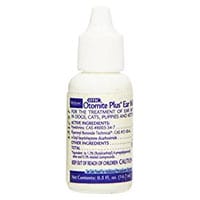 Unlike other medications carried in an ether solution, this medication is in an olive oil vehicle. While the oiliness can be messy, olive oil is gentle on the ears and can help to suffocate the mites.
Unlike other medications carried in an ether solution, this medication is in an olive oil vehicle. While the oiliness can be messy, olive oil is gentle on the ears and can help to suffocate the mites.
It is .15% pyrethrins synergized with both piperonyl butoxide and n-Octyl bicycloheptene dicarboximide.
It’s recommended that you apply 1-10 drops in each ear, gently massage it into the ear canal, and repeat the treatment once every other day or at least twice weekly until the infestation has cleared.
Negative reviews revolve around the ineffectiveness and price of the product. It doesn’t appear to cause inflammation or significant discomfort. – Buy It
Pros
- Olive oil is gentle on the ears and can suffocate mites
- Has a reputation for effectiveness
- Concentrated for application as infrequent as twice weekly
Cons
- It’s not safe to use on pregnant or nursing cats, nor should you use it to treat young kittens under 12 weeks of age
- Some customer reviews complain that the product is completely ineffective
Eradimite Review
A pyrethrin-based treatment
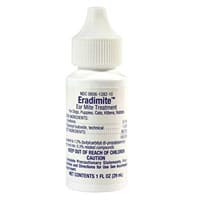 This compound contains .15% pyrethrins paired with piperonyl butoxide in an ether solution. The formula contains unidentified “soothing agents” to help your cat’s ears to feel more comfortable.
This compound contains .15% pyrethrins paired with piperonyl butoxide in an ether solution. The formula contains unidentified “soothing agents” to help your cat’s ears to feel more comfortable.
It’s recommended that you administer 10 drops and gently massage it directly into your cat’s ear. The product should be applied once every other day until the ear mites have been eradicated.
It’s not safe for nursing cats.
While some pyrethrin-based treatments earn reviews describing red, burning ears and worsening symptoms, this medication has primarily positive customer reviews. Rather than detailing frightening side effects, most unhappy customers are disappointed by the product’s inability to treat their pet’s ear mites. Others note that it has a strong, unpleasant smell and that its thick consistency makes it difficult to administer. – Buy It
Pros
- Has a reputation for effective ear mite elimination
- Formulated with soothing agents to keep your cat’s ears comfortable
- Can be applied once every other day
Cons
- Not for use on young kittens or pregnant or nursing cats
- Has a strong smell
- Some reviewers say that the liquid is too thick, making it difficult to drop into the ears
ProLabs Ear Mite Killer Lotion Review
Pyrethrin-based lotion treatment
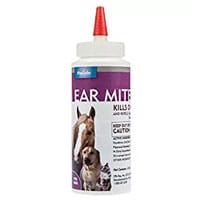 This lotion is .15% pyrethrins synergized with piperonyl butoxide and is infused with aloe to soothe irritated ears. It comes in a 6 ounce bottle and at under $7, is notably more affordable than other similar formulas.
This lotion is .15% pyrethrins synergized with piperonyl butoxide and is infused with aloe to soothe irritated ears. It comes in a 6 ounce bottle and at under $7, is notably more affordable than other similar formulas.
ProLabs instructs users to apply a thin film of treatment no more than once a day for 7-10 days.
Customer reviews are generally positive. Some say that the thickness of the lotion made it difficult to apply. A few have more serious complaints, saying that it irritated their cat’s ears. – Buy It
Pros
- One of the most affordable ear mite medications on the market
- Contains aloe to help relieve ear pain
- Customer reviews indicate that it’s effective
Cons
- You’ll need to apply it daily for 7-10 days
- It’s not appropriate for kittens younger than 12 weeks of age, nor should it be used on pregnant or nursing cats
Adams Ear Mite Treatment Review
Pyrethrin-based treatment with aloe and lanolin
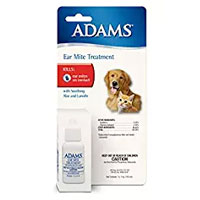 This standard pyrethrin-based ear mite medication is infused with soothing aloe vera and lanolin. It’s made with .05% pyrethrins and .5% piperonyl butoxide.
This standard pyrethrin-based ear mite medication is infused with soothing aloe vera and lanolin. It’s made with .05% pyrethrins and .5% piperonyl butoxide.
Most customer reviews are positive, saying that the product is both effective and not irritating. A handful of negative reviews describe burning ears and redness. Others complain that the product didn’t work at all.
It’s recommended that you apply 4-5 drops per ear daily for 7-10 days, plus a follow-up treatment after two weeks. – Buy It
Pros
- Made with aloe and lanolin to soothe irritated ears
- One of the most affordable medications on the market
- In most cases, it’s highly effective
Cons
- Necessitates a continuous treatment regimen
- Not safe for young kittens or pregnant or nursing cats
Zymox Otic Pet Ear Treatment with Hydrocortisone Review
Helps to eliminate secondary infections and soothes the ear
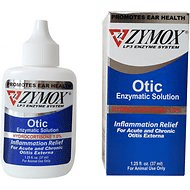
First of all, this treatment from Zymox is not a miticide. There are no insecticide agents in this product.
Despite not directly addressing ear mites, this product is an excellent ear cleaner that can help to make your cat’s ears more comfortable. Ear mite infestations are frequently accompanied by bacterial or yeast infections, and this product can help to relieve some of the itching and discharge associated with those infections.
It’s an enzymatic solution formulated to provide inflammation relief and to destroy antibiotic-resistant organisms. It cleans and disinfects ears affected by bacterial, fungal, and yeast infections. The added hydrocortisone helps to reduce inflammation, making your cat’s ears feel more comfortable.
This treatment is ideal for those who have tried mite-specific products, but haven’t seen sustained improvement. – Buy It
Pros
- Treats bacterial, yeast, and fungal infections
- Hydrocortisone soothes inflammation
- Effectively cleans out wax and other debris
Cons
- This treatment is not a miticide and won’t kill mites

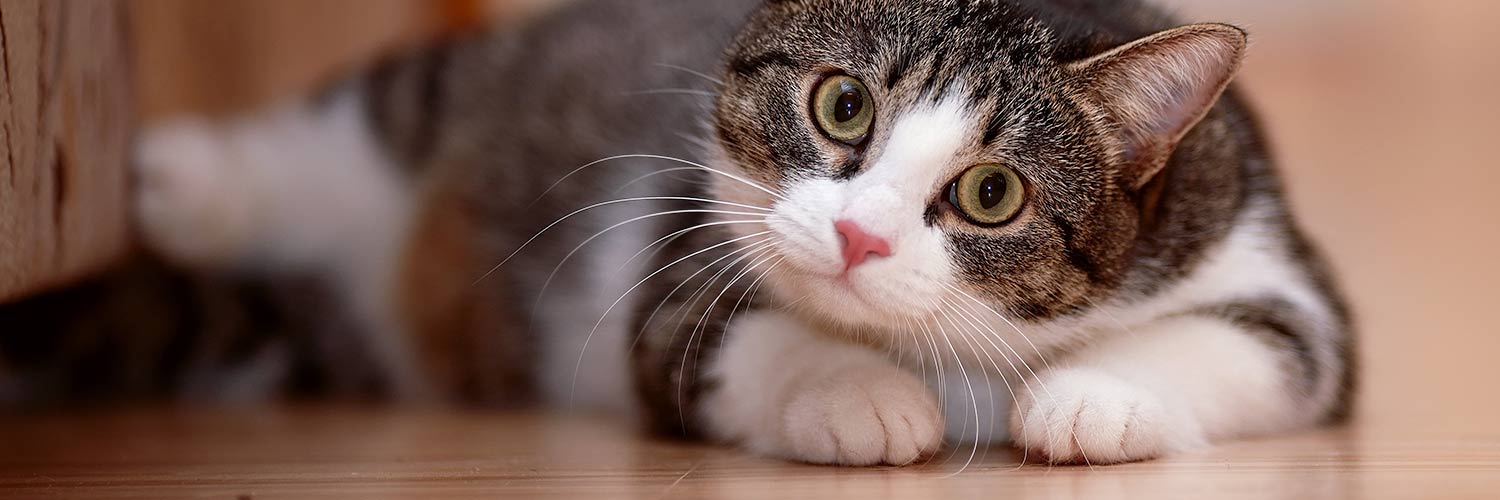






Zymox is an EXCELLENT product!
Great information but let me explain.. my mom passed away & one of her cats ears were loaded with black/brown stuff. I treated with Zymox when the cat could be caught (bit scared poor thing) used it for weeks, 1-2 treatments a week although I wish I could have done quicker. Her ears are now pink as a baby’s!
So by all descriptions she had ear mites so why did Zymox cure her?
Btw, Zymox is based with an oil. Can’t that oil smother the mites too? Just wondering.
Now I have my own two cats who have no ear discharge but shake heads when ears are touched. ?? Ugh! What is it? How do I treat this one? They hate ear treatments too & avoid me like the Plague once I start. Help!